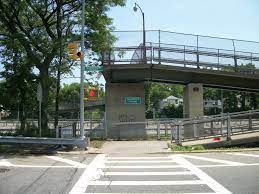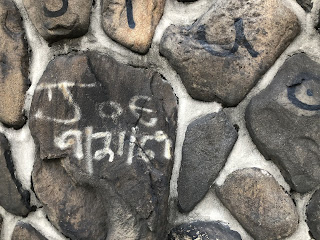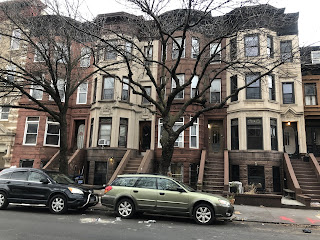"Penny Bridge." It sounds like a song from Sergeant Pepper's Lonely Hearts Club doesn't it?
But its location is less quaint, if oddly bucolic. Actually, I should say "was": That bridge, so named because it cost a penny to cross (It was privately built and operated), stood at a spot I reached on my afternoon ride.
I'd ridden into the area-- possibly the last part of Williamsburg not claimed by hipsters, trust fund kids or Hasidim--before. I had not, however, stopped at that particular spot, on Newtown Creek, until yesterday.
It's only a few hundred meters upstream from the new Kosciuszko Bridge, which has a nice pedestrian and bike lane. But that spot, on the edge of an industrial area, is out of reach of the trucks, cars and buses and, it seems, rarely visited by anyone. So, in spite of the hustle and bustle, the soot and grime all around it, it's rather peaceful.
The Penny Bridge, built over 200 years ago, was the first crossing over Newtown Creek and helped to spur industries that continues to this day. According to a marker at the site, the Creek, being a navigable waterway that empties into the East River (which is really a bay of the Atlantic Ocean), once carried more nautical traffic and freight than the Mississippi River!
I meandered along side streets, from one Brooklyn neighborhood to another, and after about 20 kilometers of pedaling, I found myself in another interesting spot about 5 kilometers from Penny Bridge:
Before today, I think I'd read or heard about the Moore Street Retail Market. Opened in 1941, it's one of the later Works Progress Administration structures built in New York City. Architecturally, it's hardly unique but certainly identifiable as a WPA structure. One reason it's interesting and important is that it's one of a series of Retail Market Places built by the WPA. (Others include the Arthur Avenue Market in the Bronx, Essex Street in Manhattan and 39th Street in Brooklyn.) While other WPA projects include everything from schools and courthouses to roadways and waterworks, the marketplaces may have been unique in their conception and purpose.

Fiorello LaGuardia's tenure as Mayor of New York City almost exactly coincided with the Presidency of Franklin D. Roosevelt, who signed the WPA into being. Though they were of opposing parties, they were allies on many issues. (Funny how crises like the Great Depression had a way of making that happen!) They both wanted to put people back to work, and LaGuardia was trying to clean up the city, literally. He was able to get the WPA to build those market places, which contain stalls of everything from fresh produce and homemade specialties from the ethnic groups living in the neighborhood to housewares and children's clothing, were meant to replace horse-drawn vending carts, which he believed to be un-hygenic and unsightly.
I'd wanted to go inside the marketplace, but the "no bikes" policy was being enforced. I propped Tosca, my Mercian fixed gear, against a pole.
"Don't leave that bike here!" Of course I wouldn't; even if I'd brought a lock with me, I wasn't about to leave Tosca, or any of my Mercians, on the street. But I think the wiry Hispanic man knew that. "That's one nice bike you've got." I thanked him. "Do you want to see mine?" Of course I did, and he pulled out his i-phone to show me images of a Throne track bike and a Trek road bike with a Creamsicle finish (which I actually liked) and, I think, Shimano 600 components. I mention that last detail because I couldn't tell which model it was, but my guess it was one of the better ones in the Trek lineup.
Another man, a friend of his, stopped to greet him and look at my bike. He, too, pulled out his phone to show me his Bianchi road bike--carbon fiber, but still in that trademark Celeste green.
So, while I didn't get to shop in the marketplace, I did pick up a few moments of cameraderie with a couple of cyclists. Perhaps I'll bump into them again.




.jpg)





































